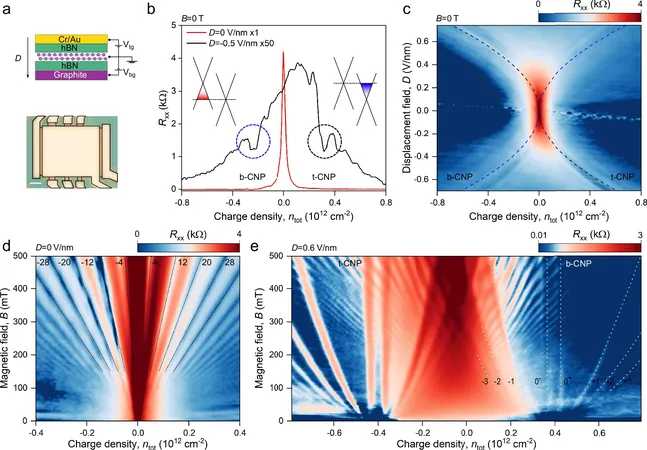
Revolutionary Advances Propel Graphene Beyond Conventional Semiconductors!
2025-08-28
Author: Ming
Graphene: The Game-Changer in Electronics
Graphene, an astonishing single layer of carbon atoms structured in a honeycomb lattice, is celebrated for its incredible strength, flexibility, and superb conductivity. Although it holds the world record for electron mobility at room temperature, it has struggled to match the performance of traditional gallium arsenide (GaAs) semiconductors at cryogenic temperatures. Now, groundbreaking research is shattering those barriers!
Breaking Down the Barriers: Electronic Disorder
A primary hindrance has been electronic disorder caused by stray electric fields from nearby defects. These imperfections distort charge distribution, generating electron-hole puddles that scatter electrons and hinder mobility. For years, this disorder has thwarted graphene's potential as an ultra-clean electronic medium.
Historic Breakthroughs from Global Researchers
In two pioneering studies led by teams from the National University of Singapore (NUS) and The University of Manchester (UK), scientists have unveiled innovative solutions that push graphene's capabilities beyond conventional benchmarks. The results showcased unprecedented records for electron mobility, competing and even surpassing GaAs in both transport and quantum mobility!
"A high mobility indicates that electrons can flow more freely through a material, crucial for the development of faster, energy-efficient electronic devices," stated Assistant Professor Alexey Berdyugin from NUS. He emphasizes the significance of these advancements for cutting-edge computing and quantum technologies.
Twisted Graphene: Nature's Shield!
The first study, published in *Nature Communications*, utilized twisted graphene layers as ultra-thin electrostatic screens. By stacking two graphene layers at angles between 10° and 30°, researchers achieved outstanding results—dramatically reducing electronic disorder. This led to staggering transport mobility exceeding 20 million cm²/Vs.
Ian Babich, a Ph.D. student at NUS, hailed this moment as revolutionary for graphene's future, allowing the exploration of delicate quantum phenomena previously deemed unreachable.
Proximity Effects: The Metallic Advantage
In a second approach published in *Nature*, Nobel Laureate Sir Andre Geim and his team placed graphene in ultra-close proximity to a metallic graphite gate. Separated by just a few atomic layers of hexagonal boron nitride, this configuration significantly reduced electronic disorder, achieving Hall mobilities surpassing 60 million cm²/Vs, breaking records.
Catalysts for Future Innovation
These complementary strategies tackle the age-old problem of charged defects hindering graphene's performance. Each technique brings unique strengths—twisted graphene offers tunable screening, while proximity allows direct observation of pristine graphene behavior.
The implications are vast: advancements in quantum metrology, ultra-sensitive sensors, and high-speed electronics could all accelerate due to these breakthroughs, paving the way for next-gen technologies.
The Future of Graphene: A New Dimension of Physics!
With ambitions to incorporate these methods into complex graphene-based structures, the researchers are excited about limitless possibilities. "These results redefine the boundaries of what graphene can achieve," said Babich. "A whole new realm of physics awaits exploration!"


 Brasil (PT)
Brasil (PT)
 Canada (EN)
Canada (EN)
 Chile (ES)
Chile (ES)
 Česko (CS)
Česko (CS)
 대한민국 (KO)
대한민국 (KO)
 España (ES)
España (ES)
 France (FR)
France (FR)
 Hong Kong (EN)
Hong Kong (EN)
 Italia (IT)
Italia (IT)
 日本 (JA)
日本 (JA)
 Magyarország (HU)
Magyarország (HU)
 Norge (NO)
Norge (NO)
 Polska (PL)
Polska (PL)
 Schweiz (DE)
Schweiz (DE)
 Singapore (EN)
Singapore (EN)
 Sverige (SV)
Sverige (SV)
 Suomi (FI)
Suomi (FI)
 Türkiye (TR)
Türkiye (TR)
 الإمارات العربية المتحدة (AR)
الإمارات العربية المتحدة (AR)